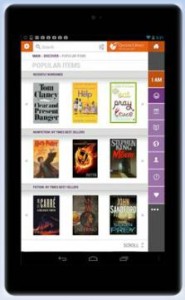Queens Library Develops Innovative New Tablet Platform Using Superstorm Sandy Donation | TDS14
 When superstorm Sandy hit the east coast in October 2012, the Queens Library (QL) in New York was among many northeastern library systems affected. QL persevered, continuing to offer crucial services in storm-ravaged communities while rebuilding damaged branches. The system also managed to turn a generous corporate donation into an innovative new platform for tablet computers, enabling a tech lending program that has since continued to grow.
When superstorm Sandy hit the east coast in October 2012, the Queens Library (QL) in New York was among many northeastern library systems affected. QL persevered, continuing to offer crucial services in storm-ravaged communities while rebuilding damaged branches. The system also managed to turn a generous corporate donation into an innovative new platform for tablet computers, enabling a tech lending program that has since continued to grow.
Kelvin Watson, VP of digital strategy and services for QL, described the program during his “Implementing New Digital Strategies in Response to a Community Emergency: The Queens Library Post Superstorm Sandy” session at “The Digital Shift: Libraries @ the Center,” a virtual event from Library Journal and School Library Journal that took place on October 1.
In October 2013, QL received 5,000 Nexus 7 tablets from Google, as part of a larger donation of 17,000 tablets to the New York State Community Action Association intended to help communities that were still on the mend. QL viewed the tablets as a means to bring mobile technology opportunities to under-served audiences and bridge the digital divide, Watson noted. The seven branches in communities most heavily affected by the storm—Howard Beach, Broad Channel, Arverne, Far Rockaway, Queens Library for Teens in Far Rockaway, Rockaway Beach, and Rockaway Park—were selected to launch the program, beginning November 20, 2013.
But first, QL had to decide what to include on these tablets. When people purchase tablets for personal or family use, they tend to build their own custom collection of content and apps, Watson said. However, for this program, “we made an assumption that the borrowers of these library tablets would often be using this mobile technology for the first time,” he said. “We also recognized that, in the Rockaways, there would be limited Wi-fi access, and that would frustrate the user if they received a device and couldn’t use it.”
So, rather than lending out “blank slate” tablets, the library opted to provide a guided experience, featuring pre-loaded content with a simple, customized “Discovery and Delivery” interface that would be easy for beginners to navigate, Watson said.
The tablets were preloaded with a variety of content, focusing on educational information, health and literacy resources, job readiness, citizenship and immigration, as well as book lists and information about library programs. The tablets are also preloaded with the OverDrive, Blio, and Acoustik Apps, enabling patrons to check out OverDrive and Axis 360 ebooks, as well as digital audiobooks. Similarly, Zinio and Freegal apps enable users to download magazines and popular music.
“We’ve also pre-installed all of the authentication and handshake processes that have been preconfigured on the device,” Watson added. “So even users who are familiar with downloadable media will find that this mobile discovery and delivery platform is a simpler experience with fewer clicks” required to discover and check out content. “We continue to add more applications to the device as we move forward with different versions,” he said.
If QL’s IT department updates or adds content to the Discovery and Delivery platform during a device’s three month checkout period (with an option for a one-month renewal) these additions or updates are applied anytime a device comes in range of QL wifi. A simple resetting procedure enables staff to apply those updates and clear a borrower’s personal information and checked out content from the device within about 90 seconds, Watson said.
The tablets are locked so that borrowers cannot purchase or download new apps. The operating systems and settings are locked on the tablets to prevent tampering or alteration, and if a device is stolen from a borrower or not returned for an extended period, the tablets can be remotely shut down—rendering them useless—and located via GPS. Watson added that restricting patron access to the settings also meant that QL has fielded few customer service calls or complaints about the devices from borrowers.
So far, the program has been a success. In June, QL announced that the program would be expanded to all of its branches, beginning with the Central Branch in Jamaica, Queens. The new tablets were honored with the American Library Association’s Library of the Future award, the New York Library Association Public Library Sections 2014 Best Practices award, and the 2014 New York State Broadband Champion: Most Innovative Broadband Project award.
The tablets ensure that “all Queens and New York City residents have multiple channels to interact with librarians and staff, materials, services and programs,” Watson said.
RELATED
ALREADY A SUBSCRIBER? LOG IN
We are currently offering this content for free. Sign up now to activate your personal profile, where you can save articles for future viewing









Add Comment :-
Comment Policy:
Comment should not be empty !!!